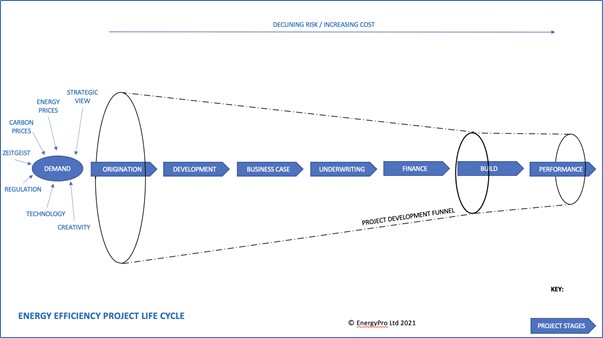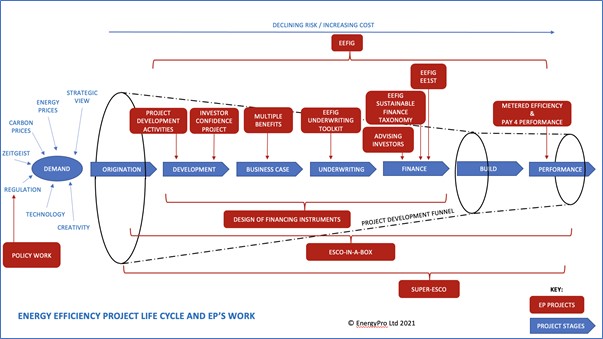Wednesday 10 November 2021
I founded EnergyPro, now re-branded ep consultancy and part of the ep group, in 2012, with the purpose of accelerating investment into energy efficiency in the belief that improving efficiency remains the best route to building a cleaner and fairer economy. Since then we have done a lot of work at every level from policy formation down to individual projects and sometimes it may be hard to see how these all fit together and support the purpose. So in this blog I thought I would explain how the parts fit together.
The model that all of our work fits into is based on a consideration of what it means to increase investment into energy efficiency. Increasing investment requires increasing the flow of viable, attractive and impactful projects through the development process from origination to financing to implementation and performance. Of course behaviour change is also important but the largest, longer-term impact comes from investment into physical projects.
The project development process, shown in Figure 1, starts with origination and then goes through development, business case, underwriting (decision making), financing, build, and finally performance. As you move through any project development funnel the quantity of projects declines as some projects fall away, and for each individual project there is declining risk and increasing cost as more resources are spent on development. An early-stage project concept has low-cost but a high risk of not happening, a fully-developed project has lower risk of not happening but getting through the development process inevitably costs money. This applies to all types of development – whether it is a building, a new product or a new company. Of course in practice project development is not so linear, it has many loops and feedbacks as different ideas are worked-up and tested and barriers are encountered and over-come.
The quantity of energy efficiency projects being originated is driven by demand which is driven by several factors including: energy prices; regulation; carbon prices; how energy is viewed strategically within an organisation; available technology; the degree of creativity applied to problem solving; and the general ‘zeitgeist’ around energy efficiency. In recent years the zeitgeist around energy efficiency has improved as more people have recognised it as the most cost-effective way to reduce emissions and reach our climate targets, as well as the multiple benefits it can bring with it.

Figure 1. The energy efficiency project lifecycle
The various projects we have delivered or are working on support different parts of the project life cycle from origination, through building business cases, delivery and measurement is shown in Figure 2.

Figure 2. The energy efficiency project life cycle and ep’s work
Our policy related work for several governments helps build capacity amongst policy makers by informing them what is possible and providing decision tools. On some occasions we have helped write policy that strengthens the case for energy efficiency by introducing new regulations or strengthening energy efficiency institutions within government.
In project development, we initiated and implemented with support from the EC and a pan-European consortium, the Investor Confidence Project Europe, which is a set of Protocols that sets out how to develop and document energy efficiency projects in a standardised way. The Investor Confidence Project’s Investor Ready Energy Efficiency™ certification system has been proven to reduce transaction costs and reduce project performance risks and is available for use by for any developer of efficiency projects across Europe. As well as having launched the Investor Confidence Project in Europe, which helps build capacity across the market, we also get directly involved in project development for a number of clients.
Our work with the Energy Efficiency Financial Institutions Group (EEFIG) since 2016 covers pretty much the whole project development process from a financial perspective. Sub-projects such the first EEFIG Working Group on the Sustainable Finance Taxonomy and the recently launched Working Group on adopting Energy Efficiency First are focused on different aspects of financing and assisting financial institutions to build capacity in order to be able to deploy more capital into efficiency. The EEFIG Underwriting Toolkit, for which we were the primary author, directly addresses the underwriting stage and helps build capacity within financing institutions and provides the basis of a common language between financiers and developers.
As well as this general capacity building work through EEFIG and other channels we have advised a number of investors looking at energy efficiency, both at project level and company level, including UK listed and private funds, several European funds, and one of the largest Sovereign Wealth Funds. Our work helps them to understand the market size and trends, identify financing mechanisms, and understand and due diligence specific investment opportunities.
Our long support for, and recent work on the multiple benefits of energy efficiency, plays directly to building better business cases for energy efficiency. As Catherine Cooremans points out, the multiple benefits are usually much more strategic, and therefore interesting to decision makers, than simple energy cost savings. Properly identifying and valuing them is essential for building effective energy efficiency business cases, business cases that maximize the chances of approval.
In working with Recurve Inc to introduce metered efficiency and pay for performance models to Europe we are addressing fundamental problems with efficiency, which are that all too often its impact isn’t measured and its true value to the system is not rewarded. Measuring and metering efficiency and flexibility, and valuing and rewarding them both properly, represents a total paradigm shift that Europe has been slow to recognise. Implementing this approach would go a long way to increasing demand for efficiency by making it contractable and much more like energy supply in that if you don’t deliver it you won’t get paid. In a pay for performance regime energy efficiency can finally become the resource we have talked about for many years.
Building on our work with investors we have advised several entities in UK and internationally, on the design of new finance instruments. Our focus is very much on the development stage as that is where there is a big gap. There is an abundance of project money for well-developed projects but too few instruments to help get projects to that point.
Looking across the whole process we developed our ESCO-in-a-box business model which enables organisations such as local energy or economic development agencies to start-up and run successful local or regional energy service companies. The model is now being rolled out in the UK and also being applied in Kenya where we are also working on linking it to a finance instrument to close the loop and bring investment. ESCO-in-a-box has also led us to work on ‘super-ESCOs’, or as we now prefer to think of them, ‘net zero development vehicles’ that can help bridge the development gap and mobilize a number of derisking tools and transaction enablers.
Hopefully that helps explain what we do and why we do it, at least on energy efficiency. If you are an energy user, a developer, or an investor, who wants to accelerate investment into energy efficiency and think we can help at any stage of the whole process of developing and delivering energy efficiency projects, we would be happy to talk.
Other parts of the ep group have different purposes and do different things: ep projects designs and develops net zero and regenerative projects in the built environment and ep asset management transfers energy transition technologies between UK and India. The group itself uses its platform to bring investment and opportunity to SMEs which impact the transition to a net zero and regenerative economy.
Comments
Comments are closed.
Dr Steven Fawkes
Welcome to my blog on energy efficiency and energy efficiency financing. The first question people ask is why my blog is called 'only eleven percent' - the answer is here. I look forward to engaging with you!
Tag cloud
Black & Veatch Building technologies Caludie Haignere China Climate co-benefits David Cameron E.On EDF EDF Pulse awards Emissions Energy Energy Bill Energy Efficiency Energy Efficiency Mission energy security Environment Europe FERC Finance Fusion Government Henri Proglio innovation Innovation Gateway investment in energy Investor Confidence Project Investors Jevons paradox M&V Management net zero new technology NorthWestern Energy Stakeholders Nuclear Prime Minister RBS renewables Research survey Technology uk energy policy US USA Wind farmsMy latest entries


